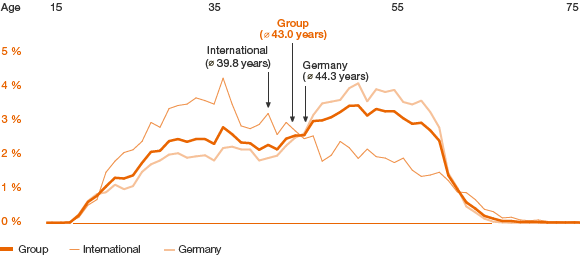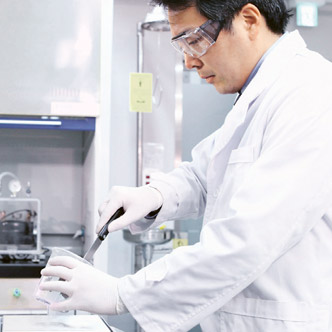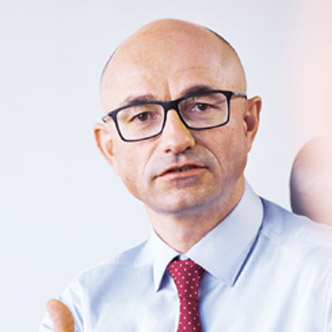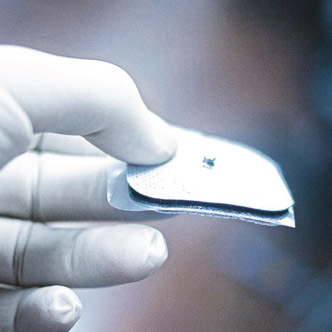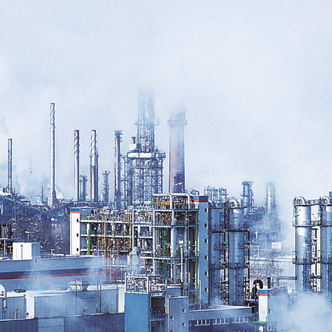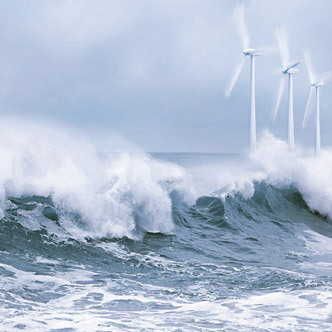Employees
Slight Increase in Staff
WACKER’s workforce increased by 1.4 percent in 2016. The main reason for the slight growth was the start-up of polysilicon production in Tennessee, USA. Siltronic continued to carry out its productivity measures in the reporting period.
71 percent of WACKER’s employees work in Germany and 29 percent at international sites.
Number of Employees at December 31
| Download XLS |
|
|
|
||||||||
|
2016 |
2015 |
2014 |
2013 |
2012 |
|||||
|
|
|
|
|
|
|||||
|
|
|
|
|
|
|||||
Germany |
12,138 |
12,251 |
12,366 |
12,322 |
12,635 |
|||||
International |
5,067 |
4,721 |
4,337 |
3,687 |
3,657 |
|||||
Group |
17,205 |
16,972 |
16,703 |
16,009 |
16,292 |
|||||
|
|
|
|
|
|
|||||
As a manufacturing company, WACKER has a large contingent of industrial workers (54.0 percent), roughly one-seventh (14.3 percent) of whom are women.
Number of Temporary Workers at December 31
| Download XLS |
|
|
|
||||||||
|
2016 |
2015 |
2014 |
2013 |
2012 |
|||||
|
|
|
|
|
|
|||||
|
|
|
|
|
|
|||||
Germany |
649 |
358 |
393 |
286 |
14 |
|||||
International |
63 |
54 |
134 |
58 |
77 |
|||||
Group |
712 |
412 |
527 |
344 |
91 |
|||||
|
|
|
|
|
|
|||||
Personnel expenses rose 2.2 percent year over year to €1,379.4 million, and included outlays for social benefits and the company pension plan amounting to €272.5 million (2015: €279.9 million). The increase in personnel expenses was due to the higher number of employees and the increase in the standard pay scale.
Personnel Expenses
| Download XLS |
|
|
|
||||||||
€ million |
2016 |
2015 |
2014 |
2013 |
2012 |
|||||
|
|
|
|
|
|
|||||
|
|
|
|
|
|
|||||
Personnel expenses |
1,379.4 |
1,350.1 |
1,246.9 |
1,133.0 |
1,196.8 |
|||||
|
|
|
|
|
|
|||||
In addition to their fixed base salary (which includes vacation and Christmas bonuses), WACKER employees usually also receive some variable compensation – a voluntary payment to employees on both the standard and above-standard pay scales. This payment comprises a profit-sharing amount and a personal-performance component. Variable compensation payments totaled €69.3 million groupwide in 2016.
The IG BCE labor union and chemical-industry employers agreed on a new 24-month collective-bargaining agreement in June 2016. The first stage of the agreement saw the standard pay scale increase by 3 percent on September 1, 2016. Effective October 1, 2017, it will rise by a further 2.3 percent. A WACKER company pension is an important compensation component and is available at most of our German and international sites, except for regions where the statutory pension appears sufficient or legal provisions are inadequate. Wacker Chemie AG’s pension fund – Pensionskasse der Wacker Chemie VVaG – provides a company pension to WACKER employees in Germany. The fund has around 17,000 members and provides pension payments to some 8,200 retirees. The average pension paid was around €650 per month. WACKER pays in up to four times its employees’ annual pension contributions, with the exact amount being determined by the type of agreement. Employees can supplement their company pensions by making their own additional contributions. WACKER matches supplementary contributions as provided for by the collective wage agreements. Employees in Germany also receive an additional supplementary pension for that portion of their salary that exceeds the pension insurance contribution assessment ceiling.
Basic and Advanced Training at High Levels
In its personnel development activities, WACKER also relies on vocational training. In 2016, 174 young people began their training at WACKER or at the Burghausen Vocational Training Center (BBiW). In total, the company employed 596 trainees, roughly the same as in the prior year (597). At 4.7 percent, the percentage of trainees (ratio of trainees to Group employees in Germany) was on a par with the prior year (4.7 percent). In 2016, WACKER offered jobs to the majority of suitable trainees – 154 graduates – hiring 41 of them on temporary contracts and 113 on permanent contracts. The BBiW also provides training for 22 partner companies.
Overall, WACKER invested €7.9 million in personnel-development measures and advanced training in 2016 (2015: €7.7 million).
Diversity and Inclusion in the Workforce
Since joining Germany’s nationwide Diversity Charter initiative in 2015, WACKER has focused every year on specific topics aimed at making employees aware of the opportunities and challenges associated with a diverse workforce. The focus in 2016 was on the company’s generational mix. The fact is that, in years to come, different generations will be working together some ten years longer than today, making the workforce more heterogeneous in this respect. This is because older employees are staying in the company longer owing to the increase in the retirement age just as younger staff enter the company sooner because of the Europe-wide harmonization of study programs in higher education and, in Germany, the reduced number of school years.
In addition to this issue, diversity management at WACKER is placing greater emphasis on gender and cultural background. People from 69 different nations work for WACKER. At the end of 2016, 43 of the groupwide total of 196 executive personnel were of non-German nationality – which corresponds to 22 percent of the total. Overall, 17 nationalities were represented at the executive level.
The German statute on equal opportunity for women and men in management that became law on May 1, 2015, has been implemented at WACKER as follows:
Executive Board: While Wacker Chemie AG attaches considerable importance to diversity as regards appointments to the Executive Board, expertise and qualifications remain the principal criteria for such appointments. There are no regular new appointments planned for the next available date (June 30, 2017). Under these circumstances, the target for the proportion of women in the Executive Board for the period up to June 30, 2017, is zero.
Management levels below the Executive Board: WACKER is focusing its attention on the two levels of management below the Executive Board as depicted in the Wacker Chemie AG organizational chart. With regard to the second reporting level, we have also decided to include only managerial employees from the highest above-standard pay scale or those who are OFK executive personnel with responsibility for managing employees.
We have also designated the period up to June 30, 2017, as the reporting period for the two management levels below the Executive Board. Because our numbers are based on the status quo as of June 30, 2015, we will have a two-year period to observe developments.
Proportion of women: We aim to increase the proportion of women in the first level of management from 8 percent to 10 percent. For the second level of management, we have set a goal of raising the proportion of women from 14.5 percent to 17.5 percent.
Idea Management: Streamlining the Process
The ideas submitted by WACKER’s employees help it to do things better and stay competitive. In 2016, the number of improvement suggestions submitted was up 6 percent year over year. The participation rate (number of submitters per 100 employees) and the total benefit rose as well. We revised the idea management system in the reporting period, and streamlined the processes for handling ideas.
WACKER has been addressing demographic change for many years. The average age of the Group’s workforce at the reporting date was 43.0. Employees at non-German sites are younger than in Germany. The age structure abroad varies greatly from region to region. Staff at Asian sites are comparatively young (average age: 35.6), while staff at US locations have an average age of 44.7. Regional variations in age structure are not exclusive to WACKER; they reflect the age structures of the populations in the respective continent or country.
Idea Management
| Download XLS |
|
|
|
||||||||
|
2016 |
2015 |
2014 |
2013 |
2012 |
|||||
|
|
|
|
|
|
|||||
|
|
|
|
|
|
|||||
Number of improvement suggestions |
7,885 |
7,429 |
7,672 |
9,159 |
8,982 |
|||||
Participation rate (%) |
32 |
29 |
30 |
32 |
34 |
|||||
Total benefit (€ million) |
7.0 |
6.8 |
8.3 |
7.7 |
4.9 |
|||||
|
|
|
|
|
|
|||||
Good social benefits, competitive compensation and motivating tasks make WACKER an attractive employer. This explains our high level of employee loyalty. The average length of service in Germany (permanent staff) was 18.8 years (2015: 18.4 years).
Employee Turnover Rate
| Download XLS |
|
|
|
||||||||||
% |
2016 |
2015 |
2014 |
2013 |
2012 |
|||||||
|
|
|
|
|
|
|||||||
|
||||||||||||
|
|
|
|
|
|
|||||||
Germany |
0.8 |
1.1 |
0.8 |
0.9 |
0.9 |
|||||||
International |
10.9 |
14.6 |
13.8 |
11.9 |
30.81 |
|||||||
Group |
3.6 |
4.6 |
4.1 |
3.4 |
7.9 |
|||||||
|
|
|
|
|
|
|||||||
A Popular Employer Among Managers
According its own managerial employees, WACKER ranks among the top three most popular employers in the German chemical and pharmaceutical industries. In the member satisfaction survey conducted every year by Germany’s Association of Chemical-Industry Executives (VAA), WACKER placed third in the reporting period. The average score for all of the 24 participating companies was unchanged from the year before at 3.1 (with 1 being the highest and 5 the lowest). With a score of 2.63, WACKER performed better than average and, at the same time, made the largest jump of any of the participating companies.
Demographic Analysis of German and International Sites in 2016
